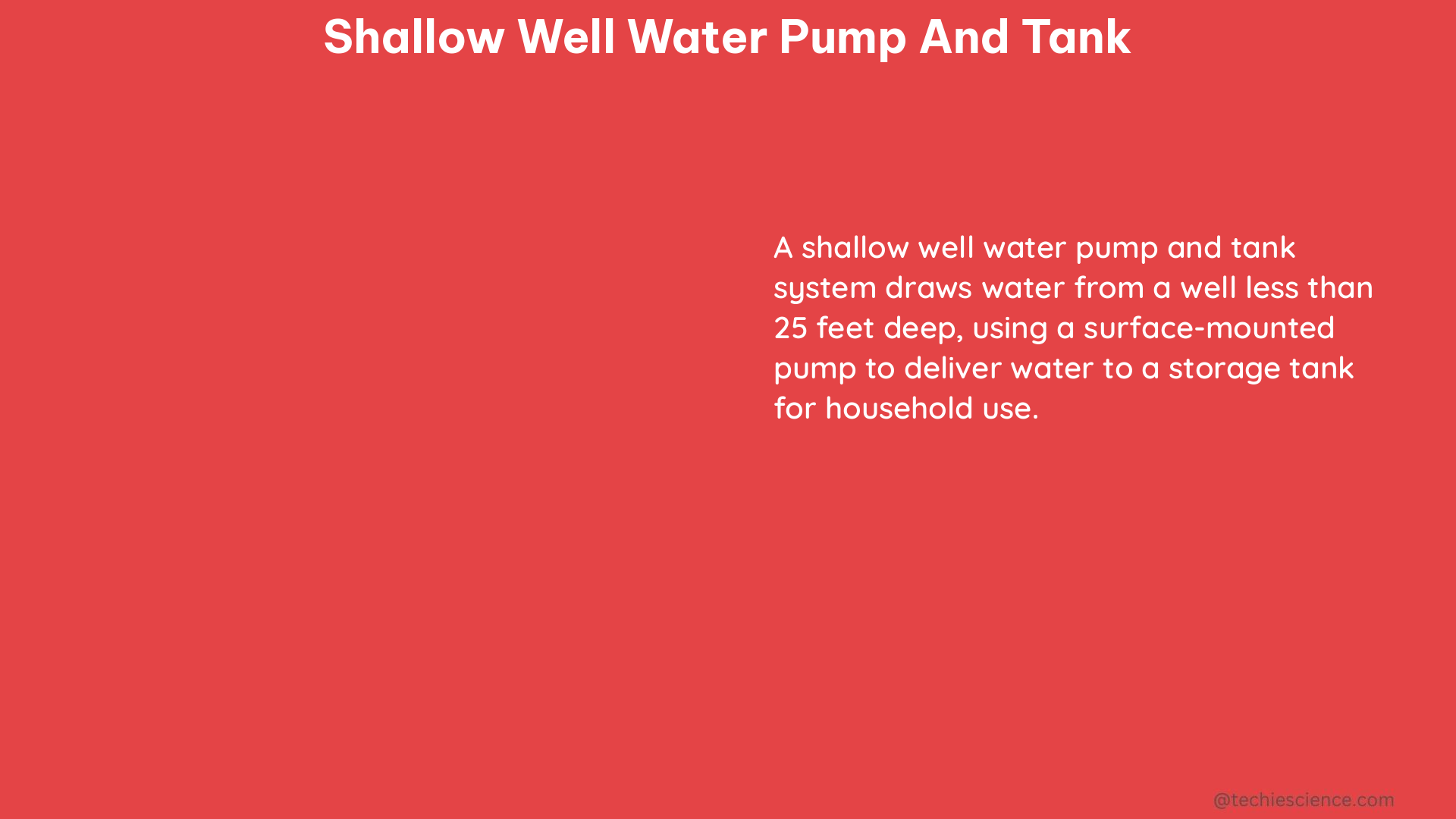Shallow well water pumps and tanks are essential components of well systems, ensuring a consistent water supply for various residential, agricultural, and industrial applications. This comprehensive guide delves into the technical specifications of shallow well water pumps and tanks, providing a detailed understanding of their key features and performance characteristics. Additionally, we will explore a step-by-step DIY approach to measuring the flow rate (GPM) of a shallow well water pump using the stopwatch method.
Technical Specifications of Shallow Well Water Pumps
Pump Types
Shallow well water pumps can be categorized into two main types:
-
Jet Pumps: Jet pumps are installed above ground and use suction to draw water from the well. They are known for their reliable performance and ease of installation, making them a popular choice for shallow well applications.
-
Submersible Pumps: Submersible pumps are installed directly in the well, submerged in the water. These pumps push the water to the surface, offering a more efficient and quieter operation compared to jet pumps.
Power Sources
Shallow well water pumps can be powered by various energy sources:
- Electrical: Electric-powered shallow well pumps are the most common, drawing power from the grid or a standalone generator.
- Gas-Powered: Gas-powered shallow well pumps are suitable for remote locations or areas without reliable electrical access.
- Solar-Powered: Solar-powered shallow well pumps are an eco-friendly option, leveraging renewable energy to operate the pump.
Flow Rate
The flow rate of a shallow well water pump is measured in gallons per minute (GPM) and indicates the volume of water the pump can deliver per minute. Typical flow rates for shallow well pumps range from 5 GPM for smaller residential applications to 50 GPM or more for larger agricultural or industrial uses.
Total Dynamic Head (TDH)
Total Dynamic Head (TDH) is a crucial specification that determines the total height a pump must lift water, including the vertical lift, friction loss in the pipes, and pressure requirements at the point of use. Selecting a pump with the appropriate TDH is essential to ensure efficient and reliable water delivery.
Motor Size
The motor size of a shallow well water pump is typically measured in horsepower (HP) and can range from a fraction of an HP for small residential pumps to several HP for larger commercial or agricultural applications.
Technical Specifications of Shallow Well Water Tanks

Tank Types
Two common types of shallow well water tanks are:
-
Bladder Tanks: Bladder tanks have an internal bladder that separates the water from the air, maintaining a consistent pressure throughout the system.
-
Diaphragm Tanks: Diaphragm tanks have a flexible diaphragm that separates the water and air, providing a similar pressure regulation function as bladder tanks.
Tank Size
Shallow well water tanks come in a wide range of sizes, from a few gallons for small residential applications to several hundred gallons for larger commercial or agricultural uses. The tank size should be selected based on the water demand and the pump’s flow rate.
Pressure Settings
Shallow well water tanks have pressure settings that determine the pressure at which the pump starts and stops. The recommended pressure for a bladder tank is typically 2 PSI (pounds per square inch) less than the well pump activation pressure. This pressure differential helps maintain the tank’s efficiency and extends the pump’s lifespan.
DIY Approach to Measuring GPM using a Stopwatch Method
To measure the flow rate (GPM) of a shallow well water pump using the stopwatch method, follow these steps:
-
Prepare the System: Ensure no water is being used in the house, and open a valve or hose bib to drain the system completely.
-
Measure the Drawdown: Check the manufacturer’s drawdown listing for your specific pressure tank or use a generic chart, like the one provided by Amtrol Well-X-Trol. The drawdown is the volume of water the tank can deliver at a specific pressure setting.
-
Start the Stopwatch: As soon as you hear the pump kick on, start the stopwatch.
-
Collect Water: Collect water in a container, such as a bucket, and measure the time it takes to fill the container.
-
Calculate GPM: Divide the volume of the container by the time it took to fill it. For example, if it takes 30 seconds to fill a 5-gallon bucket, the flow rate is 10 GPM (5 gallons / 0.5 minutes).
By following this DIY approach, you can accurately measure the flow rate of your shallow well water pump and ensure it is delivering the necessary water volume for your specific needs.
References
- Amtrol Well-X-Trol Drawdown Chart: https://www.rcworst.com/Shared/content/mfr/amtrol_well_x_trol/docs/wellxtrolsizing.pdf
- Why is the recommended pressure for a bladder tank 2 PSI less than well pump activation pressure: https://diy.stackexchange.com/questions/223798/why-is-the-recommended-pressure-for-a-bladder-tank-2-psi-less-that-well-pump-act
- Pressure tank and Shallow well pump?: https://terrylove.com/forums/index.php?threads/pressure-tank-and-shallow-well-pump.106764/

The lambdageeks.com Core SME Team is a group of experienced subject matter experts from diverse scientific and technical fields including Physics, Chemistry, Technology,Electronics & Electrical Engineering, Automotive, Mechanical Engineering. Our team collaborates to create high-quality, well-researched articles on a wide range of science and technology topics for the lambdageeks.com website.
All Our Senior SME are having more than 7 Years of experience in the respective fields . They are either Working Industry Professionals or assocaited With different Universities. Refer Our Authors Page to get to know About our Core SMEs.